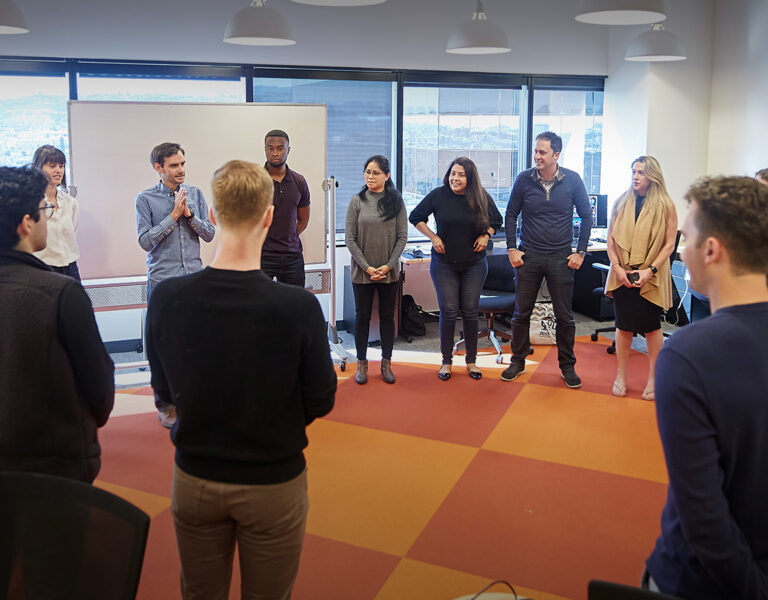Every team needs to be aligned on the best way forward. An executive offsite or strategy session can be a critical tool for business success. So what makes a great offsite?
In times of rapid change, it’s important for leaders to align quickly on objectives and actions. In most healthy organizations, we see leaders coming together for a strategy session at least once a year, and often once a quarter.
If successfully executed, a strategy session can be a transformative experience. It becomes a chance for decision-makers to step back, share some perspective on what’s going on with the business, and get aligned on how to move forward. When executed poorly, however, these sessions devolve into tedious PowerPoint shows where real issues aren’t addressed, new options aren’t put on the table, and real alignment doesn’t happen. The results aren’t a matter of luck. A few simple techniques can help any leadership team looking to have a successful session, stack the deck in their favor.
Set the challenge in advance.
Every business has multiple challenges. However, success depends on focusing the company’s collective energy on tackling the most important problems first. That said, it can be surprisingly difficult for a leadership team to clarify important challenges in real-time. Often, teams are comprised of people who are excellent at solving problems, but less adept at defining them. What’s more, the view can look different depending on where you sit. Finance leaders can see that spending is out of control, while R&D managers see the need to invest in a long-term pipeline.
You can make the most of a strategy session by defining the challenge in advance. Don’t do it in the meeting. Have a smaller team analyze ‘voice of the customer’ information, competitor trends and financial performance data to get to a clear and succinct problem definition. Conduct a round of stakeholder interviews to get input from different parts of the business. In our work, Jump has found it useful to employ a diagnostic tool to aid leaders in getting a sense of what their own managers think matters most. Individual opinions can vary greatly. But there’s usually tremendous wisdom in a company’s collective intelligence.
Keep a tight attendee list of deciders and disruptors.
Meeting organizers can feel compelled to include everyone at a particular level of seniority so that no one feels left out. As participant headcount rises, the meeting quickly becomes unwieldy, turning participants into spectators.
The most effective sessions have fewer than fifteen people, so who should come? Start with primary business leaders. With the business leaders on board, include those direct reports who will execute the resulting plan, and leave out direct reports who won’t.
Once key decision makers have been identified, go beyond decision makers to include people who’ll disrupt the conventional wisdom. For example, a consumer packaged goods team attempting to craft a Hispanic marketing strategy should bring in Latinos from their own company. Those voices will help push the conversation and disrupt old ways of thinking. To ensure you get both broad input and direct accountability, include both deciders and disruptors.
Find a hybrid facilitator.
The quality of any good meeting is dependent on a facilitator that knows how to bring out different voices, push the team’s thinking, and ensure clear alignment. That’s a skill that most of us don’t have. Even great leaders fumble with facilitation because you can’t effectively bring out different voices while also offering your own opinion. Get an outside moderator.
The best facilitators know how to push the thinking forward and they know what good strategy looks like. In short, they’re not just meeting facilitators; they’re strategists who know how to run meetings. This kind of hybrid strategist/facilitator will make sure you’ve considered everything from analogous players to forces affecting your industry; they’ll challenge your frames; they can identify seemingly good ideas that actually have a high chance of failure. Of course, they’ll get the team aligned. But they’ll also make sure that the team is aligned on the best decision possible.
Strategy Sessions that Work
Download
Get people to lean forward and create, not lean back and critique.
When strategy sessions are reduced to a daylong series of PowerPoint presentations, people lean back like they’re watching a show. If the goal is simply to give meeting updates or share information, that’s probably best done offline or via email. Of course, sharing information isn’t the same thing as buying into it. Most people simply don’t get on board with an idea if it’s presented to them. Real commitment happens when people act as co-creators of the solution.
Make the meeting a work session, not a presentation. Design the day to eliminate any time spent staring at a slideshow. If information needs to be shared, make it a pre-read. Get people in the same room, not dialing in by phone or video. Get them to roll up their sleeves, move around the room, write up their ideas and engage with the content.
Force choices, ideas and actions.
Any strategic conversation will demand some degree of abstraction and generalization. Without such big-picture thinking, you can end up having detailed conversations about how to rearrange the deck chairs on the Titanic. But even the smartest execs can struggle with thinking about ideas in the abstract.
Rather than talking about an issue in the abstract, ask participants to generate examples of how this issue manifests. Then encourage them to notice patterns in the examples they cited. Quickly follow up on those observations with a call for multiple possible solutions. Finally, select the solutions that will be the easiest to implement while having the biggest likely impact.
Successful Strategy Sessions Bridge Strategy and Culture
Strategy and culture should work together. And, done right, a strategy session can be an effective tool for both. A great strategy session can help leaders to step back and imagine bold new alternatives. Simultaneously, it can be a way to strengthen the team and the first step to shifting a culture. Great sessions should be energizing. They should be insightful. And they should leave participants amazed about how quickly they were able to get to clarity.
Success comes when teams focus on the right questions, engage people to come up with great solutions and test their ideas through experimentation. Great strategy is never the product of a single moment in time, but the hundreds of decisions that follow. Set up your sessions to enable better decision-making and move your business forward.

 Colleen Murray
Colleen Murray
 Lauren Meadow
Lauren Meadow


